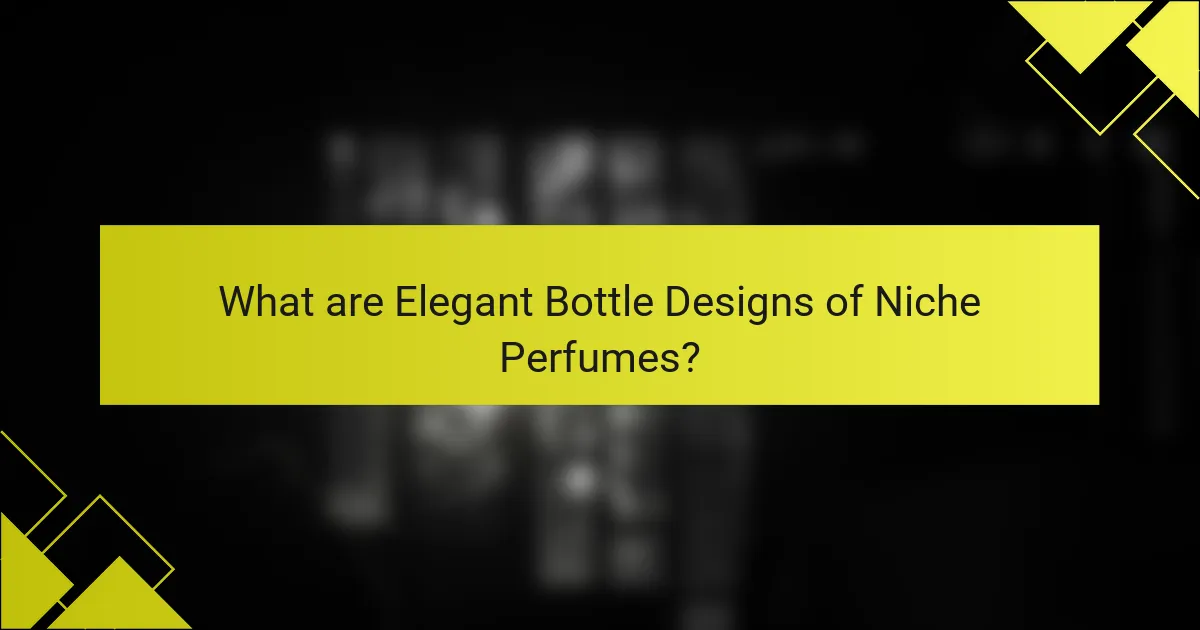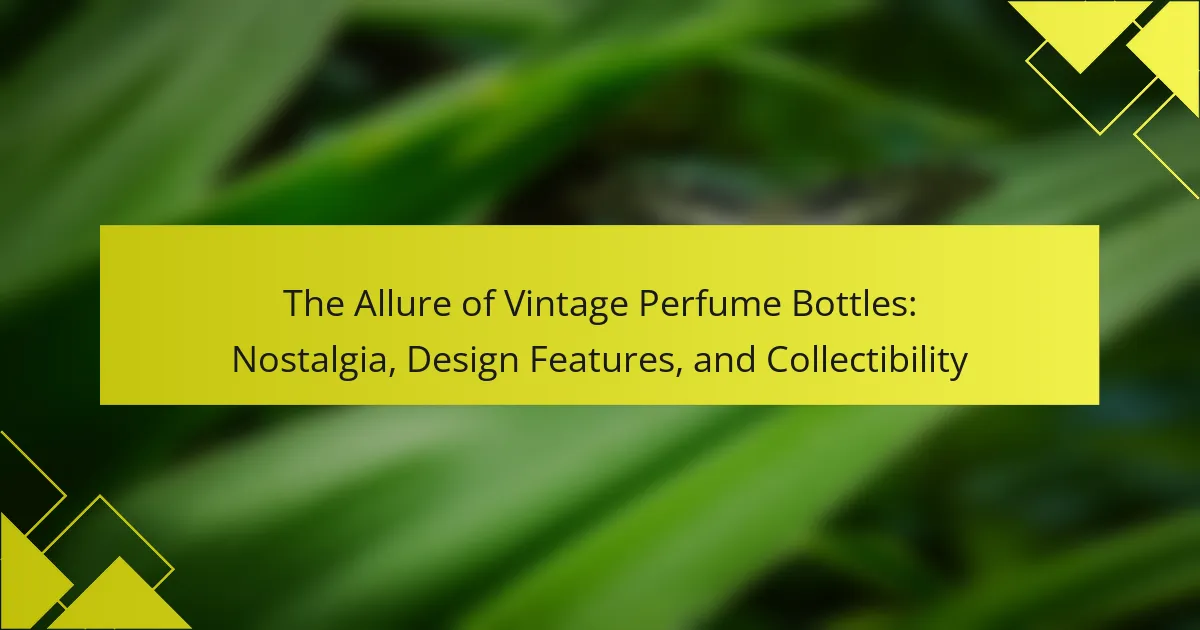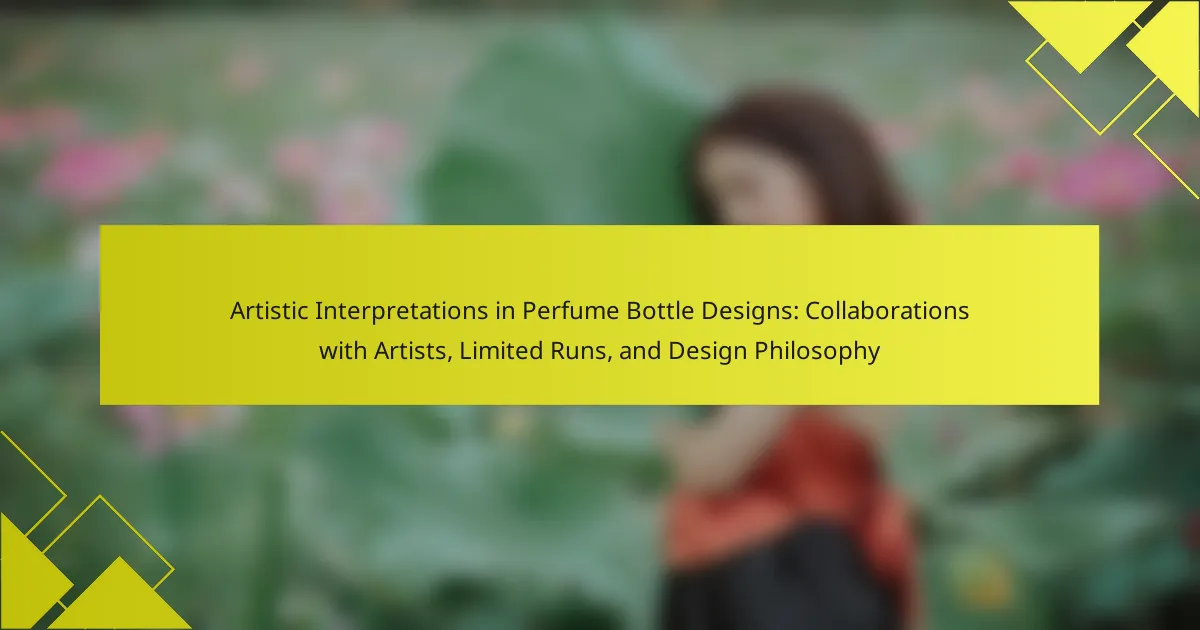
What are Elegant Bottle Designs of Niche Perfumes?
Elegant bottle designs of niche perfumes are characterized by their artistic aesthetics, high-quality materials, and functional elements. These bottles often feature unique shapes and intricate detailing that reflect the fragrance’s essence. Common materials include glass, metal, and sometimes ceramic, which enhance the overall luxury appeal. Many designs incorporate elements like hand-blown glass or artisanal craftsmanship, making each bottle a collectible item. The functionality of these bottles is also key; they typically include well-designed sprayers or caps that ensure ease of use while preserving the fragrance. Such designs not only serve a practical purpose but also contribute to the brand’s identity and storytelling.
How do aesthetic appeal and design influence consumer perception of niche perfumes?
Aesthetic appeal and design significantly influence consumer perception of niche perfumes. Attractive packaging creates an emotional connection with consumers. This connection often leads to higher perceived value. According to a study published in the Journal of Consumer Research, visually appealing designs can enhance the overall fragrance experience. Consumers associate elegant designs with luxury and quality. A well-designed bottle can differentiate a niche perfume in a crowded market. Research shows that 70% of purchasing decisions are made at the point of sale, highlighting the importance of visual appeal. Furthermore, unique bottle shapes can evoke curiosity and encourage trial. Overall, aesthetic appeal and design play a crucial role in shaping consumer perceptions and driving sales.
What elements contribute to the aesthetic appeal of perfume bottles?
The aesthetic appeal of perfume bottles is influenced by design, material, and color. Unique shapes can create visual interest and enhance brand identity. Materials like glass or crystal add a luxurious feel. Color choices can evoke emotions and attract attention. The bottle’s size and proportion affect its overall elegance. Labels and embellishments can enhance visual storytelling. Functionality, such as ease of use, also contributes to the overall design appeal. Together, these elements create a captivating presentation that attracts consumers.
How does the design of a bottle reflect the brand’s identity?
The design of a bottle reflects the brand’s identity through visual elements and material choices. Aesthetic features such as shape, color, and texture convey the brand’s values and target audience. For instance, sleek and modern designs suggest luxury and sophistication. Conversely, vintage styles may evoke nostalgia and tradition.
Material quality also plays a crucial role. High-end brands often use glass or unique materials to signify exclusivity. This choice reinforces the brand’s commitment to quality. Additionally, branding elements like logos and typography incorporated into the design create instant recognition.
Research indicates that consumers often associate specific bottle designs with particular brand attributes. A study by the Journal of Consumer Research found that packaging design significantly influences brand perception. Thus, the bottle’s design becomes a visual representation of the brand’s identity and ethos.
What materials are commonly used in the production of niche perfume bottles?
Niche perfume bottles are commonly produced using glass, crystal, plastic, and metal. Glass is favored for its ability to preserve fragrance quality and aesthetic appeal. Crystal offers a luxurious look and often includes intricate designs. Plastic is lightweight and cost-effective, making it suitable for various designs. Metal components are sometimes used for caps and decorative elements. Each material contributes to the overall elegance and functionality of the bottle.
What are the benefits of using glass versus plastic in bottle design?
Glass bottles offer superior benefits compared to plastic in design. They are non-reactive, preserving the integrity of the contents. Glass is impermeable, ensuring that flavors and aromas remain unchanged. It provides an upscale aesthetic that enhances brand perception. Additionally, glass is recyclable and environmentally friendly. According to the Environmental Protection Agency, glass recycling reduces energy consumption by 50%. Glass bottles also have a longer shelf life due to their durability against UV light. In contrast, plastic can leach chemicals into contents, affecting quality. Thus, glass is often preferred for niche perfumes.
How do different materials affect the overall quality of the perfume?
Different materials significantly affect the overall quality of perfume. The choice of materials influences the scent’s preservation, evaporation rate, and aesthetic appeal. Glass bottles are commonly used as they are non-reactive and help maintain the fragrance’s integrity. Plastic can alter the scent due to chemical interactions, leading to degradation. Metal containers may provide durability but can also react with certain ingredients. High-quality materials enhance the perception of luxury and can elevate the overall experience of the perfume. Studies show that packaging materials impact consumer perception and product longevity. Thus, the material selection is crucial for maintaining the perfume’s quality and appeal.
Why is functionality important in perfume bottle design?
Functionality is crucial in perfume bottle design because it directly impacts user experience and product usability. A well-designed bottle allows for easy dispensing of the fragrance. This prevents spills and waste, ensuring that consumers can use the product effectively. Functionality also encompasses the ergonomic aspects of the bottle. A comfortable grip enhances the ease of use for consumers during application. Additionally, the design must protect the fragrance from external factors. This includes UV light and air exposure, which can degrade the scent. Functional elements like secure closures and spray mechanisms contribute to preserving the perfume’s integrity. Overall, functionality in design ensures that the product is not only visually appealing but also practical for everyday use.
What features enhance the usability of a perfume bottle?
A perfume bottle’s usability is enhanced by features such as ergonomic design, spray mechanism, and material quality. Ergonomic design allows for comfortable handling and easy application. A well-designed spray mechanism ensures a fine mist, providing even fragrance distribution. High-quality materials, like glass, enhance durability and preserve the scent. A secure cap prevents leakage and protects the fragrance from air exposure. A transparent body allows users to monitor the remaining product easily. Refillable options promote sustainability and usability over time. These features collectively improve the user experience and functionality of the perfume bottle.
How does functionality impact the consumer’s experience with the product?
Functionality significantly impacts the consumer’s experience with niche perfume products. Effective functionality enhances user satisfaction by making the application process easier. For instance, a well-designed spray mechanism allows for precise application, reducing waste. Consumers appreciate bottles that are easy to hold and operate, contributing to a positive user experience. Additionally, functionality influences the perception of quality. A sturdy, well-functioning bottle can create an impression of luxury. Research shows that 70% of consumers prioritize ease of use in product design. Thus, functionality directly correlates with overall consumer satisfaction and brand loyalty in niche perfumes.
How do elegant designs contribute to the marketing of niche perfumes?
Elegant designs enhance the marketing of niche perfumes by creating a visually appealing identity. The aesthetic appeal attracts consumers and differentiates the product in a crowded market. Unique bottle shapes and luxurious materials convey exclusivity and quality. This visual branding can evoke emotions and establish a connection with the target audience. Research shows that consumers often associate elegant packaging with higher product value. In fact, a study published in the Journal of Consumer Research indicates that attractive packaging can increase purchase intentions by up to 30%. Therefore, elegant designs serve as a powerful marketing tool for niche perfumes.
What trends are currently shaping the design of niche perfume bottles?
Current trends shaping the design of niche perfume bottles include minimalism, sustainability, and unique artistry. Minimalist designs focus on clean lines and simplicity, emphasizing the fragrance itself. Sustainable materials are increasingly used, reflecting eco-conscious consumer preferences. Unique artistry in bottle shapes and decorations captures attention and enhances brand identity. Customization options allow consumers to personalize their bottles, adding emotional value. Additionally, multifunctional designs that serve as decor or art pieces are gaining popularity. These trends indicate a shift towards more thoughtful and expressive packaging in the niche perfume market.
What are the best practices for selecting an elegant perfume bottle design?
Select a perfume bottle design that embodies elegance through simplicity and sophistication. Focus on clean lines and minimalist shapes to enhance visual appeal. Choose high-quality materials like glass or crystal for a luxurious feel. Consider the functionality of the bottle, ensuring it provides ease of use and preserves the fragrance. Pay attention to color and finish, as these elements influence perception and allure. The design should reflect the brand’s identity and the fragrance’s essence. Research shows that consumers are drawn to aesthetically pleasing packaging, which can influence purchasing decisions.
How can consumers assess the quality of a perfume bottle before purchase?
Consumers can assess the quality of a perfume bottle before purchase by examining its design, material, and functionality. The design should reflect elegance and sophistication, indicating attention to detail. High-quality materials, such as glass or metal, often signify durability and luxury. Additionally, the bottle should have a well-functioning spray mechanism for even distribution. Consumers can also check for weight; a heavier bottle often suggests better craftsmanship. Lastly, reading reviews can provide insights into the bottle’s quality from other buyers.
What tips can help consumers choose a bottle that aligns with their aesthetic preferences?
Consumers should consider the design, color, and material of the bottle to align with their aesthetic preferences. A bottle’s design can reflect personal style, whether minimalistic or ornate. Color plays a significant role in visual appeal; consumers should choose hues that resonate with their tastes. The material, such as glass or ceramic, can convey elegance or modernity. Additionally, the shape of the bottle can influence its aesthetic impact. Unique designs can stand out and enhance the overall presentation. Research indicates that consumers are influenced by visual aesthetics when making purchase decisions. Therefore, aligning bottle choices with personal aesthetics can enhance satisfaction and enjoyment.
Elegant bottle designs of niche perfumes serve as a vital intersection of aesthetic appeal, material quality, and functionality. This article explores how unique shapes, high-quality materials like glass and metal, and ergonomic features enhance consumer perception and usability. Key discussions include the impact of design on brand identity, the significance of functionality in user experience, and current trends shaping the market. Additionally, best practices for selecting an elegant perfume bottle and tips for consumers to assess quality and align with personal aesthetics are provided.



